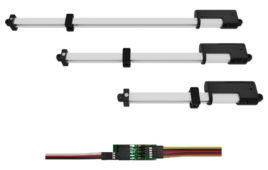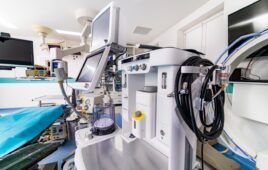Improvements in lead screw designs have meant screws that are increasingly competitive with other types of drive screws, including ball screws. For instance, lead screws can offer shorter lead times and better performance, all at a lower cost than other screw technologies. Quite a few lead screw manufacturers offer a range of anti-backlash options, superior accuracy on long lengths, as well as efficiencies over 80%, with no need for grease where TFE coatings are used.
As Matt Mowry, North American market manager for Drylin products at igus, notes, as more systems are automated, lead screws become an important motion control component. “That’s because the market is looking for lower cost and more options as far as diameter and lead,” says Mowry. “The lead screw part of the drylin product line is the fastest growing segment, especially in the high-helix geometry (dryspin).”
The improvements and expanded range of options mean more design latitude for designers. This is especially helpful given other industry-wide trends, such as the evolving nature of the relationship with customers and their requirements for more customized solutions from manufacturers. That’s where customization services are offered to meet highly specific demands as well as the tools to help designers select just the right fit for their applications.

Customized spline rails with programmable IDEA Drives from Haydon Kerk Motion Solutions and Pittman combine a lead screw, guidance, and control in a single compact unit.
One company familiar with the customization trend is Haydon Kerk Motion Solutions and Pittman. As Keith Knight, Manger of New Product Innovation puts it, “We have always used our catalog product as the starting point for serving our customers, but quickly adapt our product to meet the unique needs of their application. So much so that approximately 80% of product we sell is customized. More recently we have seen activity grow from customization of products, to fully custom axes of motion, or multiple axis sub-assemblies.”
The company is seeing other trends, among which is a diversity of industries and applications. “From lab automation, to medical devices, to food and beverage and beyond this trend has continued to accelerate over the past several years and we expect this to continue,” says Knight. “One explanation is that many of our customer’s products require motion, but motion is not necessarily their area of expertise. They recognize the value of partnering with a highly technical motion component manufacturer where the value presents itself as reduced design and development time, lower overall costs, and a high degree of coordination and accountability between groups as the product moves from prototype through to full production,” adds Knight.
Another example of the trends of higher performance and customization comes from Thomson Industries. A recent product combines a lead screw with a hybrid stepper motor with a built-in antirotational guidance. The aim is to simplify integrating linear actuator devices into systems and using a lead screw offers many benefits.

These motorized lead screw actuators (MLA) from Thomson Industries are ideal for applications with stroke lengths shorter than 2.5 in., loads lighter than 200 lbf on various motor sizes, and requiring speeds below 20 in./sec. Linear resolution options range from 0.063 to 7.5 µin. of linear travel per step.
The company has expanded its line of stepper motor linear actuators with models featuring built-in anti-rotational guidance. The new motorized lead screw actuator (MLA) product saves designers of high-precision, shorter-stroke applications the cost, time and maintenance worries related to designing and building externally guided systems themselves.
The load of a typical stepper motor linear actuator attaches to a nut that rides back and forth as the screw turns. Translating the rotational motion of the motorized lead screw into the axial motion needed to move the load back and forth requires restraining the nut. Traditionally, application designers accomplish this with external guidance assemblies, but these can take up valuable space and add cost and complexity. The Thomson MLA design eliminates the need for external guidance by surrounding the shaft with an aluminum cover tube with molded internal splines that lock onto the nut to keep it from turning. This design also features an integrated bushing that enables it to withstand small radial and moment loads.
The new Thomson MLA is best suited for space-constrained, force-sensitive applications requiring shorter strokes that must be repeated with high precision. Examples include adjusting a microscope slide stage, tilting a computer monitor or vertically positioning a pipette onto a test tube array.
Filed Under: Ballscrews • leadscrews, Linear Motion Tips, Trends, Motors • stepper





Tell Us What You Think!